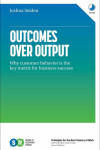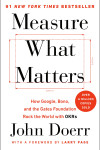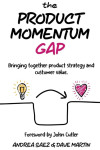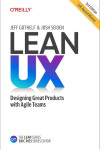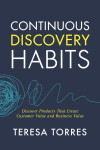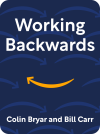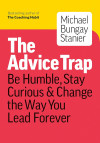Continuous Discovery Habits
Discover Products that Create Customer Value and Business Value
"Continuous Discovery Habits: Discover Products That Create Customer Value and Business Value" is a comprehensive guide to modern product management practices. It focuses on the critical process of product discovery—the ongoing effort to understand customer needs and identify valuable product opportunities. Torres challenges traditional project-based discovery methods, introducing a systematic framework for continuous customer research and product development that helps teams make better decisions through regular learning and experimentation.
The book introduces practical tools and techniques, including the Opportunity Solution Tree (OST) framework, a visual tool that helps teams connect business outcomes to customer opportunities and potential solutions. Through detailed examples and actionable approaches, Torres demonstrates how teams can move from sporadic customer research to a sustainable, continuous discovery practice that keeps them closely aligned with customer needs and market dynamics.
At its core, the book advocates for weekly customer touchpoints, collaborative decision-making, and a focus on outcomes over outputs. It provides concrete techniques for conducting compelling customer interviews, mapping opportunities, and testing assumptions before making significant product investments. Throughout, Torres emphasizes measuring success by the value created for customers and the business, not just by features shipped, offering product managers a practical roadmap for implementing sustainable discovery practices.
By reading Continuous Discovery Habits, you will:
- Master the practice of continuous customer interviewing, learning how to ask the right questions and extract meaningful insights that drive product decisions
- Implement the Opportunity Solution Tree framework to connect business outcomes with customer needs and potential solutions, ensuring your product development efforts stay focused on what matters
- Develop techniques for testing assumptions and ideas quickly and cheaply, reducing the risk of building the wrong features or products
- Transform your product team's approach from project-based to continuous discovery, creating sustainable practices for ongoing learning and improvement
Related books:
- "Testing Business Ideas" by David J. Bland and Alexander Osterwalder:
A comprehensive handbook providing practical methods and tools for validating business and product assumptions through systematic experimentation. Perfectly complements Torres' approach to assumption testing and opportunity validation. - "Lean UX" by Jeff Gothelf and Josh Seiden:
Presents a practical framework for applying lean principles to user experience design, sharing the continuous discovery mindset of rapid learning and iteration. Essential companion for teams implementing modern product development practices. - "Radical Focus" by Christina Wodtke
Introduces effective OKR (Objectives and Key Results) implementation through an engaging narrative, helping teams better connect their discovery work to measurable outcomes and strategic goals. - "High Output Management" by Andrew Grove
A seminal work on technology management that provides the organizational foundation needed to support effective continuous discovery practices. Offers valuable insights on creating the operational excellence required for sustainable discovery habits. - "The Art of Innovation" by Tom Kelley
Reveals IDEO's proven approaches to fostering creativity and innovation, providing additional techniques for ideation and opportunity exploration that complement Torres' structured discovery process. - "Escaping the Build Trap" by Melissa Perri:
Expands on focusing on outcomes over outputs in product management
I believe this is a very important read
-
Continuous discovery requires weekly customer touchpoints conducted by the team building the product, ensuring ongoing learning and adaptation.
-
Success in product development comes from focusing on outcomes over outputs, measuring impact rather than feature delivery.
-
The Opportunity Solution Tree provides a visual framework for connecting business outcomes to customer needs and potential solutions.
-
Effective discovery requires testing assumptions early and, often, using small experiments to validate ideas before making significant investments.
-
Product teams must resist the urge to rush to solutions and instead spend time understanding and mapping the opportunity space.
-
Opportunity Solution Tree
A visual tool for mapping the relationship between desired outcomes, customer opportunities, and potential solutions. Helps teams make better product decisions by maintaining clear connections between business goals and customer needs. -
Continuous Interviewing
The practice of conducting regular customer interviews, which is focused on understanding behavior and needs rather than gathering feature requests, is essential for maintaining current customer understanding. -
Assumption Testing
A systematic approach to validating product ideas through small experiments, focusing on desirability, viability, feasibility, and usability assumptions. -
Outcome-Focused Development
Shifting focus from outputs (features shipped) to outcomes (impact achieved), ensuring product development efforts drive meaningful results. -
Opportunity Mapping
Process of identifying and organizing customer needs, pain points, and desires before moving to solution generation.
Q: What is continuous discovery and why is it important?
A: Continuous discovery is an approach to product development that involves regular (at least weekly) interactions with customers by the product team. It’s important because it allows teams to stay closely aligned with customer needs, rapidly test ideas, and make informed decisions based on real user feedback.
Q: What is the Opportunity Solution Tree (OST) and how is it used?
A: The Opportunity Solution Tree is a visual tool for mapping the product discovery process. It connects business outcomes to customer opportunities and potential solutions. The OST helps teams visualize their product strategy, prioritize opportunities, and track assumptions and experiments.
Q: How should product teams approach customer interviews?
A: Product teams should focus on understanding customer needs, pain points, and desires rather than asking what features to build. They should ask for specific stories about recent experiences and avoid leading questions. The goal is to uncover underlying needs rather than validate preconceived solutions.
Q: What’s the difference between outputs and outcomes in product development?
A: Outputs are the features or products delivered, while outcomes are the changes in customer behavior or business results that those outputs create. Torres emphasizes focusing on outcomes, representing the value created rather than just completed work.
Q: How can teams generate and evaluate product ideas effectively?
A: Teams should initially focus on generating a high quantity of ideas, separating idea creation from evaluation. They should welcome unusual ideas and use a mix of individual and group ideation sessions. Ideas should then be evaluated based on how well they address the identified opportunity and their potential impact on desired outcomes.
- When transitioning from project-based to continuous product development: This book provides the framework and practical techniques to implement sustainable discovery practices that align with modern product development needs.
- When struggling to make product decisions confidently: Learn how to systematically gather and interpret customer insights, moving beyond gut-feel decision-making to evidence-based product development.
- When your team is shipping features but needs to see desired business outcomes, discover how to connect customer needs with business outcomes, ensuring your product development efforts drive meaningful results.
- When seeking to establish a sustainable customer research practice: Perfect for teams looking to move beyond sporadic customer interviews to a consistent, effective research practice.
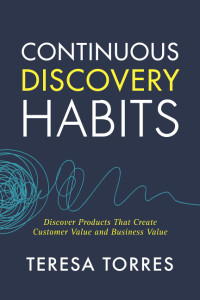
Your support helps me maintain and improve the book recommendations for everyone.
